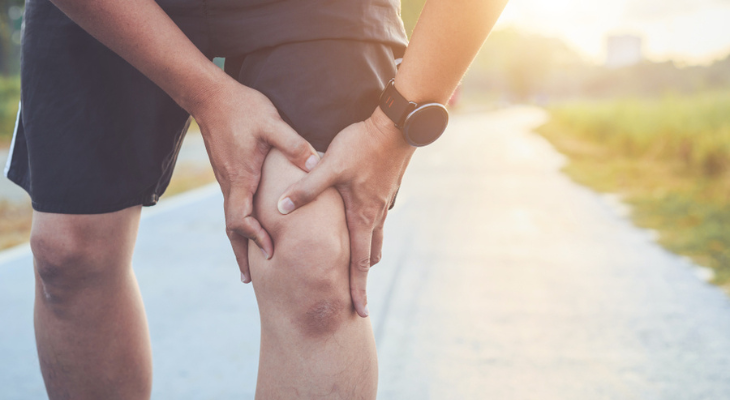
Treating Patellofemoral Pain Syndrome (Runner's Knee) with Chiropractic Care
It may be known as "runner's" knee, but you don't have to be a runner to develop patellofemoral pain syndrome. This common knee condition affects more than 22% of Americans every year, according to a systematic review and meta-analysis published in PLOS One in 2018. Luckily, chiropractic care can help you manage your pain.
What Is Patellofemoral Pain Syndrome?
Patellofemoral pain syndrome affects the front of the knee, including the area in and around the kneecap. The condition may occur due to:
- A Misaligned Kneecap
- Overuse Injury
- Gait Problems
- Activities That Involve Frequent Jumping, Running, or Squatting
- Tight Achilles Tendon or Hamstring
- Weakness in the Thigh Muscles
- Excessive Pronation (Rolling the Feet Inward When Walking)
According to the American Academy of Orthopaedic Surgeons, you may be more like to develop patellofemoral pain syndrome due to abnormal tracking (movement) of the kneecap or leg alignment issues.
Any type of activity that bends or stresses the knee, like jumping, squatting, running, climbing, or even walking up a flight of stairs can trigger or worsen your knee pain and cause grinding or popping sounds. Pain can also be a problem when sitting due to the stress on the knee. In some cases, the knee can become stiff, weak, or unstable.
Easing Your Pain with Chiropractic Treatment
Chiropractors focus on treating your pain and preventing it from returning. During your visit, you'll receive a thorough examination that will help your chiropractor diagnose the reason for your knee pain. As part of the diagnosis process, you may receive an X-ray or other tests.
Sometimes knee pain has unexpected causes. For example, a misalignment in the vertebrae in your lower spine could trigger an imbalance in your thigh muscles. If your muscles aren't balanced properly, your kneecap may become misaligned. Realigning the vertebrae with spinal manipulation not only relieves pain but may also reverse the imbalance and help improve muscle strength.
Spinal manipulation, one of many helpful treatments your chiropractor offers, restores the alignment of your vertebrae. Adjusting misaligned vertebrae offers many benefits, including natural pain relief, inflammation reduction, improved blood flow, and enhanced flexibility. The treatment only takes seconds and involves moving the vertebrae back into place with quick thrusts of the hand or an activator.
In a research study published in BMC Musculoskeletal Disorders in 2008, researchers reported that patients with patellofemoral pain syndrome had greater improvements in pain and function after spinal manual therapy (spinal manipulation) over those who only performed exercises.
Other chiropractic treatments that may be part of your patellofemoral pain syndrome treatment plan include:
- Joint Alignment. This treatment may be used to gently realign your knee joint and reduce stiffness.
- Soft Tissue Therapy. Massage and other soft tissue therapies relieve stiffness and soreness, help improve flexibility, and improve muscle imbalances.
- Ultrasound Therapy. Soundwaves produced during ultrasound therapy heat the deep tissues in and around your knee. The therapy improves pain and spurs healing.
- Orthotics. Properly supported feet are essential for good knee and leg alignment. If you have excessive pronation or another issue that affects the feet, your chiropractor may recommend orthotics. These custom-designed shoe inserts keep your feet aligned correctly when you wear shoes, in addition to improving support and comfort.
- Exercises. Your chiropractor may also recommend exercises to strengthen the muscles that support your kneecap.
Ready to say goodbye to patellofemoral pain syndrome? Contact our office to schedule an appointment with the chiropractor.
Sources:
PLOS One: Incidence and Prevalence of Patellofemoral Pain: A Systematic Review and Meta-Analysis, 1/11/2018
https://www.ncbi.nlm.nih.gov/pmc/articles/PMC5764329/
American Academy of Orthopaedic Surgeons: Patellofemoral Pain Syndrome, 10/2020
https://orthoinfo.aaos.org/en/diseases--conditions/patellofemoral-pain-syndrome/
BMC Musculoskeletal Disorders: Effectiveness of Local Exercise Therapy Versus Spinal Manual Therapy in Patients with Patellofemoral Pain Syndrome: Medium Term Follow-Up Results of a Randomized Controlled Trial, 5/15/2021
https://bmcmusculoskeletdisord.biomedcentral.com/articles/10.1186/s12891-021-04310-9
WebMD: Runner’s Knee: What You Need to Know, 12/15/2021
https://www.webmd.com/pain-management/knee-pain/runners-knee
